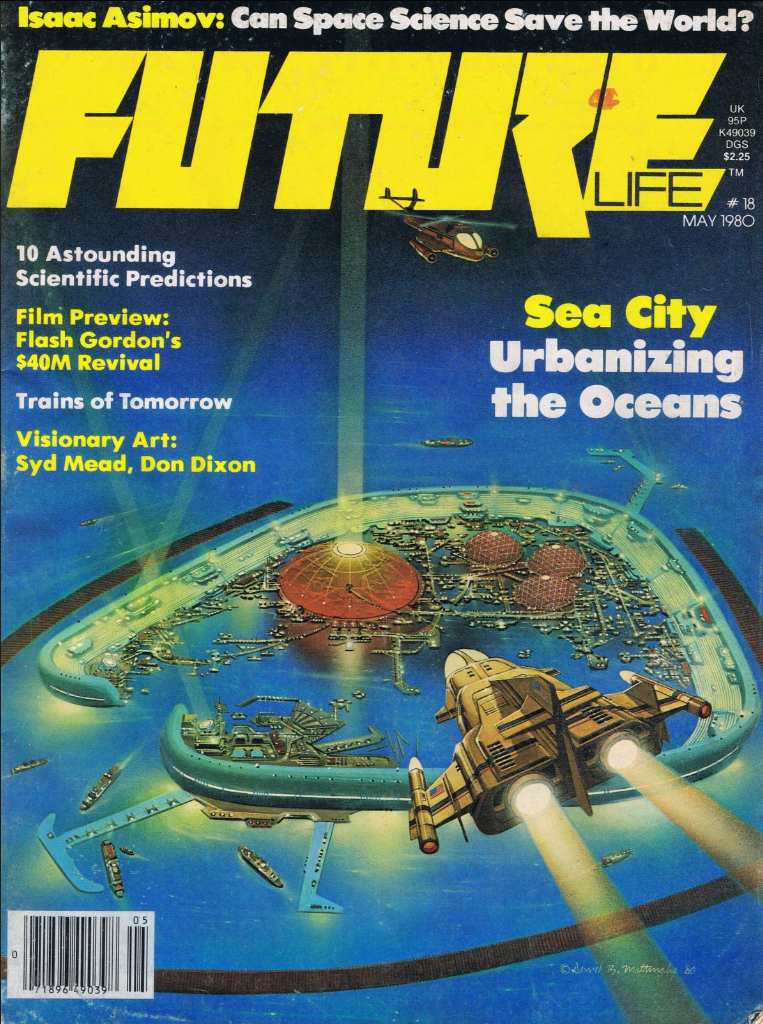
SEA CITY: Will human-made islands of concrete and glass save the world from doomsday?

ON THE COVER: Sea City, an industrial complex and functioning community, is envisioned by artist David Mattingly. In the future, such human-built habitats in the oceans may contribute to solving many of our energy and food supply problems. For the story of this ambitious proposal, see page 18.
An innovative proposal for a habitat of the future designed to solve some of the problems of today
By ADAM STARCH ILD and JAMES HOLAHAN
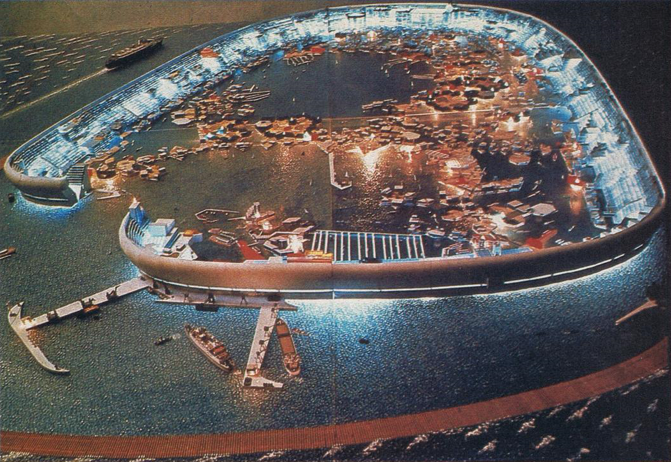
Some of the world's most articulate scientists, politicians, economists and sociologists appear to have joined together in a school of thought, the purpose of which is to forecast doom in a world that they see as overpopulated, overpolluted and undersupplied with the natural resources needed to maintain the high level of energy requirements for a burgeoning world population. Not only are we critically short of the resources for a world energy supply (they say), but we are also facing an impending world food shortage, the likes of which boggle the imagination. One prominent science writer has projected a cut-off date of 50 years hence, at which time he envisions great hordes of people leaving the cities, swarming across the land like locusts in search of food.
To the believers of this creed of doomsday, the entire concept seems endowed with an aura of inevitability; just as with the weather, it is coming, and there is little that anyone can do about it. Fortunately, however, in the case of doomsday, a few people around the world are doing something.
Take the Pilkington Glass Company of England, for example.
The Pilkington Glass Company's dream for the not-too-distant future is an island of concrete and glass that could be constructed in the shoals (shallows) of the oceans around the world. This is envisioned as being not only largely self-supporting, but also capable of producing goods for export to the nearby mainlands. It is designed not merely as an industrial project, but as a city that could house and provide food, utilities, education, medical facilities and recreation for a population of some 30,000 persons. The name chosen for the model of this futuristic appearing island city is, aptly, Sea City.
Since oceans cover three-fourths of the world's surface, with approximately 10 percent of this area consisting of shoals, the ideal topography for Sea City is widely available. Some suggested areas that would be suitable are: Martha's Vineyard (off the coast of southeast Massachussetts); extensive areas of both the Yellow Sea and the East China Sea; off the coast of Israel, as well in the oil- producing Persian Gulf; off the South American coast, extending from the vicinity of Rio de Janeiro southward to the River Plate; in the Gulf of Mexico; and large areas from the Java Sea northward to the Gulf of Siam. The Baltic Sea around Europe contains large shoal areas, as does the northern half of the Adriatic Sea, between the coasts of Italy and Yugoslavia. The North Sea, Black Sea and Irish Sea could all provide shoal areas for Sea City.
At this writing, Sea City is somewhat more than just an idea. Design details have been developed by its designers, architect Hal Moggridge, climatic and ocean engineer Ken Anthony, and structural and civil engineer John Martin. An artist's concept of the project has been developed and photographed. Not only do its enthusiastic supporters see this island city as a functional economic unit, they also see it as providing an aesthetically pleasing, warm and healthy environment for its inhabitants.
According to the artist's concept of Sea City, if you were to view it from a helicopter you would get the impression of a huge amphitheater with tiered 'bleachers' extending from the base of the amphitheater rim to its top. This amphitheater design allows the structure to encircle a sheltered lagoon that contains clusters of artificial floating islands. The 'bleachers' of the main structure are in fact storied apartments and industrial buildings, with the entire tiered section of the main structure comprising 16 stories. Access to the inside of the amphitheater is gained by an opening that faces toward the mainland shore; this opening is in effect a harbor entrance to the inner lagoon. The actual, physical size of the amphitheater is projected as being 4,700 feet from north to south, and 3,300 feet across at its widest point. The city is afforded protection from sea breakers by an encircling breakwater on the seaward side.
The construction techniques of Sea City will follow the traditional methods that have been developed in bridge building, etc. The initial step of the construction is the driving of piles (precast and barged from the mainland) into the seabed at 20- to 30-foot intervals. Next, deck sections of reinforced, precast concrete are towed to the site, where they are jacked up onto guide rails between the rows of piers. These deck sections are locked in place on the piles to form a continuous cellular slab. To complete this foundation, concrete is poured to fill the voids around the pile structure.
The next construction phase of this main amphitheater structure is the placing of prefabricated concrete cells on the base. Those cells, prefabricated on the mainland, are transported to the site in bottomless barges, where they are to rest on the base, starting at a point 30 feet above the highest anticipated level of the sea. The cells are winched up temporary ramps onto the base, where they are mounted one above the other on spacer units. Each cell forms either a small flat or a portion of a large one. The spaces that surround the four sides of the cells are used as conduits for gas, water, electricity and sewage. To finish the main structure, each cell is stressed down to the one below to form a uniform, massive structure.
To utilize the sheltered lagoon to its fullest, islands are constructed in it which provide a base for everything from housing to playgrounds for children and industrial facilities, with a network of connecting pathways between the islands. The islands of the lagoon are triangular concrete pontoons, 60 feet wide, and held in position by anchor chains. The rigid sections, which are linked together by flexible couplings to allow for the movement of the water, form a modular type of construction, which allows the islands to be uncoupled and recoupled in various combinations to form islands of various shapes and sizes, up to 10,000 square feet in area. The top platforms of the island, which overlap the pontoons, support lightweight, fiberglass reinforced plastic buildings of up to three stories in height. The pontoons, which contain buoyancy compartments and storage areas, are equipped with ballast tanks that can be flooded or pumped out to level the rigid sections with each other, regardless of the load bearing on them.
If Sea City is to function as the designers envision it, it must do so in an artificially warmed, climatically controlled environment, protected from any wind or rough seas that might occur. The protection from the sea is afforded by a breakwater which is constructed seaward of, and around, the city. This breakwater effectively creates a trench or 'moat' of calm water that surrounds the outer perimeter of the amphitheater. The breakwater is made up of 100-foot-long by six-foot-diameter bags, filled to 90 percent with fresh water, and anchored side by side with flexible cables. When an incoming breaker strikes the breakwater, a secondary wave is generated inside each bag, which rebounds against the end of the bag and creates a damping action against the incoming sea breakers.
As further insurance that the inner lagoon of Sea City remains calm, a curtain of compressed air bubbles up from an undersea pipeline, rising to the surface across the harbor, or lagoon entrance.
Protection from winds is created by the structure of the amphitheater itself. In tests conducted at Leicester University, it was found that the optimum shape of the 180-foot-high wall would be that of an outward leaning figure 'S'. The wind tunnel experiments indicated that such a surface would deflect the wind upward to a height that would leave the area below relatively calm, resulting in a large, slow-moving vortex of air that moves back toward the direction of the wind, causing the air that passes over the terraces on the inner surface of the wall to move for aesthetic appearance, as well as heat and light transmission and insulation properties to reduce glare and solar overheating. These factors should produce a comfortable, pleasant environment for Sea City residents.
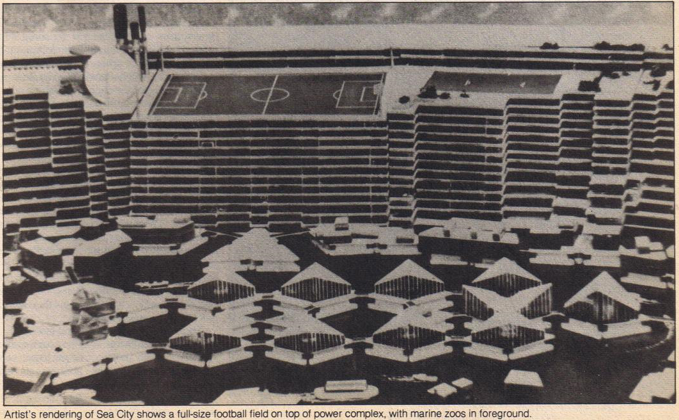
To reduce noise, as well as pollution of the lagoon, all the internal transportation will be by electrically powered boats and water buses, with battery recharging units placed around the city to replace the familiar land- based 'service stations'. As planned, a five- minute water bus service can complete a circuit of the city in 25 minutes. There will be a one-way traffic system around the base of the terraced wall, where it is anticipated that traffic will be heaviest. Elsewhere in the lagoon, persons can travel at their own discretion. Landing islands will service those boats that are not moored beneath the terraced wall. Concrete landing pads are spaced around the lagoon, and boats can also be boarded by way of watertight doors in the sides of the pontoons, or from outside stairways.
To avoid traffic congestion in the inner lagoon, visitors will be required to moor their boats at the berths provided near the lagoon entrance. Supply barges and container ships will bring supplies to the city, where ample storage space will be available; however, even in the event of a natural disaster the city would not be cut off from supplies, because hovercraft have already been developed that can travel safely at 30 knots in strong winds, over 10-foot waves.
Commuters will travel between Sea City and the mainland by hovercraft or helicopter- bus. Storage space for commuter autos will be provided in the form of a multi-deck parking garage on the mainland, and travel from there to Sea City's heliport would take 15 to 30 minutes by helicopter-bus.
Just as any land-based city, Sea City will be internally self-governing, with the local government center located at the social hub of the city. Many of the public buildings, such as the nursery, primary and secondary schools, etc., will be located on the floating islands. None of the shops, schools or other facilities will be more than a one-mile walk by way of a network of footpaths and bridges, 13 feet above sea level, connecting the floating islands to each other and to the terraced wall.
Sea City will be serviced by a 200-bed hospital, clinics and dental services. Mortuary services will be in the form of a crematorium which is located just outside the city wall. The city's internal comunications system will allow the residents to call for fire, police and government services exactly as we do now in any land-based city. To link the city's communications system to that of the rest of the world, an underwater cable to the mainland will connect into the world telephone and telegraph system.
To provide social and cultural facilities for the residents, there will be community centers, youth clubs, tea-gardens, two theaters, movie houses, libraries, an art gallery, a museum, and churches for all denominations. The City will maintain public gardens with flowers and shrubs chosen slowly upward. The tests further indicated that this slow-moving air mass will extend for some distance across the lagoon and will be maintained there by the thermal currents generated by the warm air mass that emanates from the mainland city.
The original plans for Sea City call for it to be located near a natural gas field. The gas will be piped to a processing plant on one end of the city, from where it will be fed to highspeed turbines that are coupled to electricity producting generators, to supply the electrical needs of the island city.
The essence of the success of Sea City is conservation , and to this end, the heat from the turbine exhaust gases will be used to provide energy for a desalination plant, as well as for domestic and industrial heating and refrigeration. The coolant water of the generating plant, the temperature of which will be raised considerably in the process, will be dumped directly into the lagoon, thus raising the temperature of the lagoon water an anticipated five to seven degrees above that of the surrounding ocean water.
To keep the heated water within the lagoon, where it will help in the maintenance of the artificially warmed climate, sluice gates will be installed beneath the supporting base platform. In good weather, the sluice can be opened to allow the natural tidal currents to cleanse the lagoon.
Sea City can be expanded in the future with no major technical problems to overcome, as new terraced walls can be built outside the main structure, and concentric with it. Such a design would create more lagoons of heated water.
The terraced section of the amphitheater comprises 16 stories of apartments that are centrally heated and/or air-conditioned, and will provide housing for 21,000 of the anticipated 30,000 residents of the city. Other residents will live in individually designed houses on the island of the lagoon. To avoid monotony in design, the format and size of the apartments are varied, with some apartments having up to seven rooms. Most of the apartments will be provided with terraced gardens. The apartment windows facing the lagoon are designed to give the residents at least two and a half hours of winter sunshine a day. The seaward side of the lower eight stories of the main structure will be used for offices and industrial facilities; the seaward side of the upper eight stories also have windows facing seaward.
Access to the city's gardens, shops, clubs, restaurants, etc., will be by escalators, travelators and covered walkways. The internal distribution of goods will be done by a network of pneumatic tubes and conveyors. The glass of the various structures will have a variety of special qualities, including tinting especially for the warm climate.
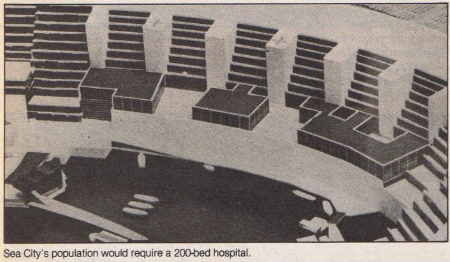
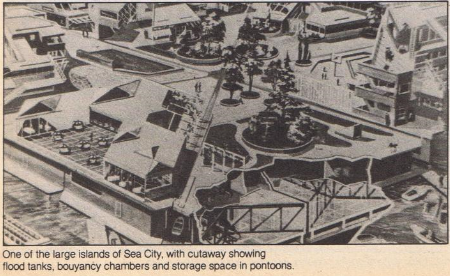
Sports-minded residents from children to adults are considered in Sea City's plan, with the central part of the lagoon being the hub of water sports. Weekend sailors, water skiers, and swimming and diving enthusiasts will actually be able to enjoy their sports years round because of the artificially warmed climate of Sea City. There will also be a tennis court, as well as a full-sized football field, on top of the power complex.
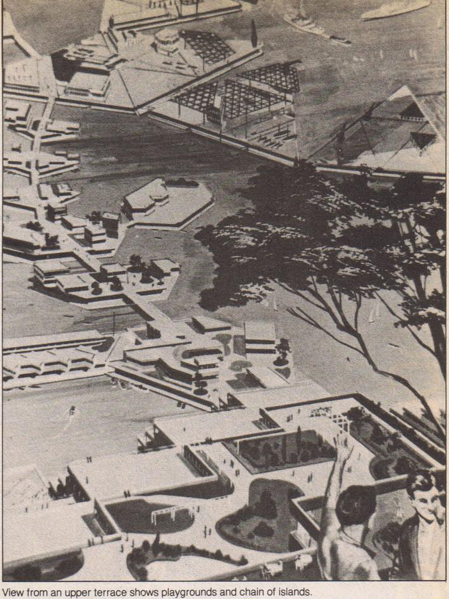
As desirable as all of these amenities of living may seem, the reason for Sea City's existence is not relaxation and pleasure, but productivity. The sea has for eons been the catch-basin for minerals that leach out of the soil and are carried to the oceans in streams and rivers. We know that life proliferates in many forms in the oceans, and moreover, that more natural resources must lie beneath the sea bed than we have yet tapped under the land. The very water of the oceans is the essence of life on Earth. Oceanography and undersea study is coming of age, and should form a basis of marine industry of the future.
The Sea City prototype should be extremely important to the development of a host of marine industries. It could house a College of Marine Studies, complete with submarine laboratories and a marine zoo with observation posts, as well as research vessels. Such a college is seen as a first step toward a University of the Sea. The industrial and economic possibilities are far-reaching and dramatic:
Boat building: In recent years the sales of boats, both commercial and pleasure, have risen steadily. Sea City's lagoon facilities are easily adaptable to the industry of boat building, an industry which could contribute significantly to its economy.
Sand and ballast dredging: Land-based construction has a voracious appetite for sand and ballast, creating the possibility of a dredging industry for Sea City.
Minerals and metals: Sea water contains useful minerals and metals. Admittedly, the concentrations of these elements is low, but the recoverable amounts are quite large. For example, sea water with a salinity of 3.433 percent contains 1,272 p.p.m. (parts per million) of magnesium (used in the manufacture of optical mirrors, precision instruments, etc.). Bromine (used in the manufacture of pharmaceuticals, dyes, etc.), which occurs in sea water at about 13 p.p.m., was commercially extracted as long ago as 1924. Further, such metals as strontium (used in fireworks, flares, etc.), rubidium (resembles potassium and is used in photoelectric cells, etc.), copper and other metals can be recovered from sea water, as well as nodules of manganese dioxide that are found on the sea bed. Precious metals, such as gold, could be extracted from the brine concentrate of the City's desalination plant. The power complex could produce a by-product of nitrogen, resulting from free nitrogen extracted from the air, which would lead to the development of new fertilizer and chemical plants.
Organic fertilizers: Another source of income for Sea City would be from fertilizers manufactured from seaweed and sewage.
Water: The large desalination plant that is planned for the City would enable it not only to provide its own fresh water needs, but also pipe water to the mainland, where formerly arid land could be turned into orchards and gardens. Undoubtedly, when enough island cities such as Sea City exist, viable methods of transporting water for long distances to interior regions will be developed. The produc¬ tion of water alone would justify the existence of Sea City.
Food: Water is the natural environment for man's most nutritious and plentiful - but perhaps least exploited food: fish. Commercial fishing, as it is generally practiced, is a somewhat inefficient way of harvesting the bounty of the oceans. Fish farming , on the other hand, is becoming recognized as one of our most efficient methods of producing high-quality food, because fish have an extremely high conversion ratio of feed consumed to meat produced. And the warm- water environment of Sea City would be ideally suited to the culture of almost all the fish that we traditionally buy in the markets, including most of the flat fish (ling-cod, sole, etc.) as well as trout, salmon, shrimp, etc. The culture of oysters, clams, and other shell fish would undoubtedly be successful.
A major advantage of this kind of food production, which combines the best of both artificial and natural environments, is the speed with which fish feed can be converted to food for man. In temperature-controlled tanks, with intensive management, and with a fish feed that could be processed from such waste products as sewage, the yield from Sea City fish farms should equal, if not exceed, the productivity of any warm-water pond now in operation in America or Europe, where a pond-acre normally produces something on the order of five tons of fish per year. And such a farming enterprise would tie in with the industry of fish canning.
The operation of Sea City's many industries and services will provide employment not only for Sea City residents, but also for workers from the mainland.
How long before the Sea Cities of the world become reality? The answer to that question cannot be easily arrived at. We know that the technology for such a project is available - the Pilkington model has proved that. Now it remains for some entity - governmental, corporate or a partnership thereof - to commit to an investment in Sea City; an investment in the future.